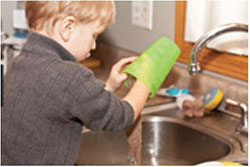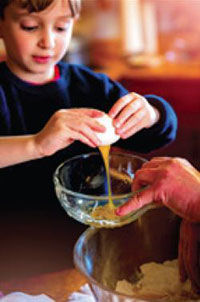Mindful Lifestyles
Shelby Rundell-Le, 4-H Youth Development/Family & Consumer Science Agent, Gunnison County

When someone tells you to be mindful, it’s not about minding your manners. Mindfulness is paying attention to how you live your life. Mindful behaviors involve making conscious decisions in your daily life, such as making healthier food choices, stopping eating when your full and choosing to become more physically active. There are countless benefits to practicing mindfulness. Being aware of what your body needs and making thoughtful decisions can lead to a well-rounded healthy lifestyle. Even small changes in choices can add up in a big way with boosted energy, improved mood and reduced health problems for children and adults.
Mindful Eating
When we chose to select healthier foods, we are practicing mindful eating. Eating more slowly and savoring the flavor is also mindful eating. It includes developing an awareness around food and how it fuels our bodies. It also involves paying attention to how foods affect us physically, emotionally and mentally and finding comfort in eating.
Mindful Moving
Mindfulness also encompasses our physical activity. Noticing how you feel before, during and after moving or exercising is part of mindful moving. Simple changes such as stretching, taking a morning walk, parking far away from the door or vacuuming can make a difference over time. Being active promotes healthy development in children and adults, allowing us to be a part of our family’s lives as we age. Being active is different for everyone. No matter the age or gender, chances are there is something you enjoy.
Involving Kids

Kids have a natural curiosity and interest in both foods and physical activity. It is valuable to get them started early as it is the foundation to their relationship with a healthy lifestyle. Children can begin learning healthy eating habits very early. Toddlers and infants channel all their senses when they eat. They feel, smell, look at and taste their food before they decide to eat. Typically, the younger the child the closer they are to practicing mindful eating. As a parent it is valuable to use mindful eating techniques to encourage kids to select healthier foods and recognize when they are full on their own.
Strategies for Success
- Involve children in meal preparation and food selection. Kids learn by doing, so engage them in menu planning and grocery shopping. Make them your assistant in meal prep and cooking. Let them wash and mix foods. Kids can set the dinner table and select the beverages. Get them excited about food and eating by letting them be a part of the activity. By making them aware of the whole progression of meal preparation, they are encouraged to find joy in the foods they eat with willingness to try new ones.
- Talk about food. Educate your kids about the value of healthy food choices and why their small growing bodies crave them. Let them know that certain foods help them run faster, heal from injuries and grow big and strong. Try not to label foods as “bad” or “good”, rather help them understand why healthy foods are good for them.
- Be a role model. Kids are able to pick up on your attitude and beliefs towards foods. It is important they see parents choosing to eat a variety of healthy foods without hesitation and stop eating when they are full.

- Explore new foods. When eating children use their senses more than we realize. Try foods with a funny name and experiment with different textures and colors. Teach kids to make meals with alternatives, such as mashed cauliflower or broccoli tots.
- Don’t reward eating healthy with something that is not. Rewarding kids with an unhealthy treat for eating a good one won’t help them develop mindful eating habits. Rather this teaches them to associate eating vegetables with discomfort/pain and having sweet sugary foods with success and pleasure. Instead, reward kids for their healthy choices with encouragement, activities or games, while keeping dessert an occasional treat which is not connected to meal time.
Let’s Talk
Help children establish mindful behaviors early in life with physical activity and healthy eating patterns. By adopting basic practices, you can be a valuable role model for your child. No matter the season, be active with your kids both inside and outside. Visit a corn maze, go pumpkin or apple picking, rake leaves and let the kids jump in the pile!
Recipes for Health:
Cauliflower Crust Pizza
Crust Ingredients:

- 1/2 large head cauliflower (or about 2 cups shredded cauliflower)
- 1 large egg
- 1 cup finely shredded mozzarella cheese
- 1 teaspoon dried oregano
- ½ teaspoon dried or fresh minced garlic
- ½ teaspoon onion powder
Toppings:
- 1/2 cup pizza sauce
- 1/2 cup shredded mozzarella cheese
- Veggies of choice
Preheat the oven to 450° F. Using a food processor, process the cauliflower into small crumbles. Transfer the cauliflower to a microwave safe bowl. Microwave the cauliflower crumbles until dry, about 8 minutes. Allow crumbles to cool 5-10 minutes, then mix with the remaining crust ingredients until uniform. Transfer the crust to a nonstick pan. Pat the crust into the desired shape, lightly spray the top with cooking spray and bake 15 minutes or until golden brown. Remove the crust from the oven, and turn the oven to broil. Apply the sauce on top of the crust, sprinkle with cheese and remaining ingredients. Broil pizza 3-4 minutes, until the toppings are tender and the cheese has melted. Cut into slices and serve immediately. Adapted from Kendall Reagan Nutrition Center, Colorado State University





